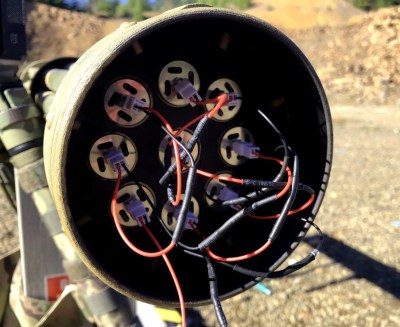
As their prospects for victory in the Second World War became increasingly grim, the Germans developed a wide array of outlandish “Wonder Weapons” that they hoped would help turn the tide of the war. While these Wunderwaffe obviously weren’t enough to secure victory against the Allies, many of them represented the absolute state-of-the-art in weapons development, and in several cases ended up being important technological milestones. Others faded away into obscurity, sometimes with little more then anecdotal evidence to prove they ever even existed.
One of these forgotten inventions is the Fliegerfaust, a portable multi-barrel rocket rocket launcher designed for use against low-flying attack planes. Although thousands were ordered to defend Berlin in 1945, fewer than 100 were ever produced, and there’s some debate about how many actually survived the war. But that didn’t stop [Jonathan Wild] of Wild Arms Research & Development from building a functional replica of the weapon based on contemporary documentation and blueprints.
Building the launcher was relatively straightforward, as it’s little more than nine tubes bundled together with a handle and a simplistic electric igniter. The trick is in the 20 mm (0.78 inch) rockets themselves, which are spin stabilized by the exhaust gasses exiting the four angled holes on the rear. With no fins or active guidance the path of each rocket is somewhat unpredictable, but this was known to be true of the original as well.

Historical records disagree on how the rockets were actually fired, some state each barrel was ignited in sequential order while others claim the rockets were launched in volleys. [Jonathan] decided to design his igniter circuit so that all the rockets would be triggered simultaneously, but due to variations in the propellant, they leave the launcher at the staggered pace seen in the demonstration video below.
From a purely historical standpoint, this project is an absolute triumph. Considering the weapon was last known to have been used during the Battle of Berlin, there’s an excellent chance that no living person had seen or heard one fired up until this point. Of course we’ll never know how it compares to the real thing, but at least we have more context than a few B&W pictures could provide. [Jonathan] says he’s currently working on a book that details how the researched and built his replica, which we’re eager to get a look at.
For those wondering about the legality of such an endeavour, [Jonathan] has been in close contact with the Bureau of Alcohol, Tobacco, Firearms and Explosives (BATFE) and made sure all Local, State and Federal laws were followed during the development and testing of his replica. As there is no explosive warhead in the rockets and the launcher doesn’t used a fixed ammunition, this device would appear to fall into the same category as a cannon or muzzle loading rifle — which technically are not considered firearms in the United States. That said, there’s certainly some room for interpretation here and specific laws can vary by State, so dabbling in homebrew Wonder Weapons isn’t recommended unless you’ve got a good lawyer on speed dial.
0 Commentaires